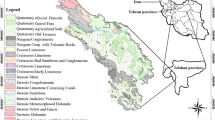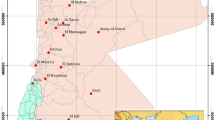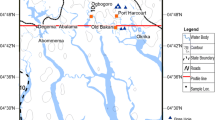Abstract
Geochemical characteristics and potentially toxic element contents of groundwater, thermal springs, and cold springs of Taftan area in the southeast of Iran examined in two different seasons in order to assess their quality and possible contamination source. Groundwater and spring water samples were collected in May and September 2012 and analyzed for major parameters, anions, cations, and potentially toxic elements. Groundwater is the local source of drinking water and along with cold springs is used for agricultural irrigation. Thermal springs are mainly used for bathing and balneological purposes. For both wells and springs under study, boron was found to have the higher concentration than the specifications in WHO standards except for PF spring. Arsenic, Fe, Mn, Pb, and Ni in thermal springs and most of groundwater samples and cold springs indicate higher concentration than those of WHO standard. The low Na/Ca and Na/K ratios in STS and TTS thermal springs confirm these waters associated with up-flow zones, while higher Na/K ratios for cold springs reveal effects of lateral flows. Conservative elements indicate that thermal springs fall within the hydrothermal field, indicating magmatic affiliation of the thermal waters. High concentrations of trace elements and major ions in well water, thermal springs, and acidic cold springs provide evidences for water–rock interaction processes and the presence of active deep circulations. Saturation indices (SI) show that thermal waters are oversaturated with respect to quartz, chalcedony, alunite, gypsum, celestite, and barite, evident by precipitation of sulfate and siliceous minerals in the most recent precipitates of the geothermal system. The cold springs and groundwater are oversaturated with chalcedony, quartz, hematite (four water wells), and goethite (two water wells), slightly highlighting the mixing of the groundwater with thermal and acidic springs. The SI indicates that the Fe-phase minerals could control mobility of As in the groundwater of the Taftan area. The present study is addressing a significant risk of toxic elements in groundwater resource management, in the volcanic regions in the southeast of Iran, and suggests some preventive measures for controlling adverse effects of using such waters for drinking and irrigation.








Similar content being viewed by others
References
Aksoy N, Simsek C, Gunduz O (2009) Groundwater contamination mechanism in a geothermal field: a case study of Balcova, Turkey. J Contam Hydrol 103:13–28
Agusa T, Kunito T, Fujihara J, Kubota R, Minh TBM, Trang PTK et al (2006) Contamination by arsenic and other trace elements in tube-well water and its risk assessment to humans in Hanoi, Vietnam. Environ Pollut 139:95–106
Angelone M, Cremisini C, Piscopo V, Proposito M, Spaziani F (2009) Influence of hydrostratigraphy and structural setting on the arsenic occurrence in groundwater of the Cimino-Vico volcanic area (central Italy). Hydrogeol J 17:901–914
Barati AH, Maleki A, Alasvand M (2010) Multi-trace elements level in drinking water and the prevalence of multi-chronic arsenical poisoning in residents in the west area of Iran. Sci Total Environ 408:1523–1529
Berman E (1980) Toxic metals and their analysis. Hayden and Sons, Philadelphia
Bhattacharya P, Claesson M, Bundschuh J, Sracek O, Fagerberg J, Jacks G, Martin RA, Storniolo A, Thir M (2006) Distribution and mobility of arsenic in the Rio Dulce alluvial aquifers in Santiago del Estero Province, Argentina. Sci Total Environ 358:97–120
Birkle P, Merkel B (2000) Environmental impact by spill of geothermal fluids at the geothermal field of Los Azufres, Michoacán, México. Water Air Soil Pollut 124:371–410
Boomeri M (2004) Geochemistry, petrography and formation style of Taftan Volcano. Research Project Report, University of Sistan & Baluchistan, p 118 (in Farsi).
Brown KL, Simmons SF (2003) Precious metals in high-temperature geothermal systems in New Zealand. Geothermics 32:619–625
Brugger J, Long N, McPhail DC, Plimer I (2005) An active magmatic hydrothermal system: the Paralana hot springs, Northern Flinders ranges, South Australia. Chem Geol 222:35–64
Buschmann J, Berg M, Stengel C, Sampson ML (2006) Arsenic and manganese contamination in Cambodia: relation to ‘micro-topography’?. In: Philadelphia Annual Meeting. 22–25 Oct.
Chen CJ, Chiou HY, Tai TY (1996) Dose response relationship between ischemic heart disease mortality and longterm arsenic exposure. Arterioscler Thromb Vasc Biol 16:504–510
Cortecci G, Boschetti T, Missi M, Lameli CH, Mucchino C, Barbieri M (2005) New chemical and original isotopic data on waters from El Tatio geothermal field, northern Chile. Geochem J 39:547–571
Di Napoli R, Aiuppa A, Bellomo S, Brusca L, D’Alessandro W, Candela EG, Longo M, Percoraino G, Valenza M (2009) A model for Ischia hydrothermal system: evidence from the chemistry of thermal groundwaters. J Volcanol Geotherm Res 186:133–159
Edmunds WM, Bath AH, Miles DL (1982) Hydrochemical evolution of the East Midlands Triassic sandstone aquifer, England. Geochim Cosmochim Acta 46:2069–2081
Gansser A (1971) The Taftan volcano (SE Iran). Eclogae Geol Helv 64:319–334
Gemici U, Filiz S (2001) Hydrogeochemistry of the Cesme geothermal field, western Turkey. J Volcanol Geotherm Res 110:171–187
Giggenbach WF (1991) Chemical techniques in geothermal exploration. Application of Geochemistry in Geothermal Reservoir Development (Co-ordinator D’Amore, F.). UNITAR/UNDP Centre on Small Energy Resources, Rome, pp 119–144.
González EP, Tello EH (2001) Interaction between geothermal water and springs at the Los Humeros geothemal field, Puebla, Mexico. Ing Hidraul Mex XV(2):185–194
Henke KH (2009) Arsenic: environmental chemistry., Health threats and waste treatmentWiley, Chichester, p 588
Henley RW, Stewart MK (1983) Chemical and isotopic changes in the hydrology of the Tauhara geothermal field due to exploitation at Wairakei. J Volcanol Geotherm Res 15(4):285–314
John De Zuane PE (1990) Chemical parameters-inorganics. In: Quality standards and constraints. Von Nostrand and Reinhold, New-York, pp 47–151.
Joseph EP, Fournier N, Lindsay JM, Fischer TP (2011) Gas and water geochemistry of geothermal systems in Dominica, Lesser Antilles island arc. J Volcanol Geotherm Res 206:1–14
Kim MJ, Nriagu J, Haack S (2002) Arsenic species and chemistry in groundwater of southeast Michigan. Environ Pollut 120:379–390
Kim MJ, Nriagu J, Haack S (2003) Arsenic behaviour in newly drilled wells. Chemosphere 52:623–633
Keshavarzi B, Moore F, Mosaferi M, Rahmani F (2011) The source of natural arsenic contamination in groundwater. Water Qual Expo Health, West of Iran. doi:10.1007/s12403-011-0051-x
Komatina MM (2004) Medical geology: effects of geological environments on human health, vol 2., Developments in earth and environmental sciencesElsevier, Amsterdam, p 500
Landrun JT, Bennet PC, Engel AS, Alsina MA, Pasten PA, Milliken K (2009) Partitioning geochemistry of arsenic and antimony, El Tatio Geyser Field, Chile. Appl Geochem 24:664–676
Lopez DL, Bundschuh J, Birkle P, Armienta MA et al (2012) Arsenic in volcanic geothermal fluids of Latin America. Sci Total Environ 429:57–75
Lopez-Chicano M, Ceron JC, Vallejos A, Pulido-Bosch A (2001) Geochemistry of thermal springs, Alhama de Granada (southern Spain). Appl Geochem 16:1153–1163
Marcovecchio JE, Botte SE, Freije RH (2007) Heavy metals, major metals, trace elements. In: Nollet LM (ed) Handbook of water analysis, 2nd edn. CRC Press, London, pp 275–311
Meyback M (1987) Global chemical weathering of surficial rocks estimated from river dissolved loads. Am J Sci 287:401–428
Moinvaziri H, Aminsobhani E (1978) Etudes Volcanologique du Taftan. Ecole normale superieure de Tehran, Tehran.
Moore F, Shakeri A, Kompani-Zare M, Raeisi A (2005) Geothermometry and hydrogeochemistry of Taftan thermal springs. In: Proceeding 9th symposium of geological society of Iran, Tehran. 30–31 Aug 2:22–36 (in Farsi)
Mosaferi M, Yunesian M, Dastgiri S, Mesdaghinia AR, Esmailnasab N (2008) Prevalence of skin lesions and exposure in drinking water in Iran. Sci Total Environ 392:69–76
Mosaferi M, Yunesion M, Mesdaghinia A, Naidu A, Nasseri S, Mahvi AH (2003) Arsenic occurrence in drinking water of IR of Iran: the case of Kurdistan Province. In: Ahmed MF, Ali MA, Adeel Z (eds.) Book: fate of arsenic in the environment- BUET-UNU international symposium, February. Tokyo, Japan 7 International Training Network Centre, Bangladesh University of Engineering and Technology, Dhaka, Bangladesh and the United Nations University, pp 1–6.
Needleman HL (1993) The current status of childhood low-level lead toxicity. Neurotoxicology 14:161–166
Nicholson K (1993) Geothermal fluids. Springer, Berlin
Pal T, Mukherjee PK, Sengupta S (2002) Nature of arsenic pollutants in groundwater of Bengal basin: a case study from Baruipur area, West Bengal, India. Curr Sci 82:554–561
Ragunath HM (1982) Ground water. Wiley Eastern, New Delhi
Rahman MM, Chowdhury UK, Mukherjee SC, Mondal BK, Paul K, Lodh D et al (2001) Chronic arsenic toxicity in Bangladesh and West Bengal, India—a review and commentary. Clin Toxicol 39(7):683–700
Shakeri A, Moore F, Kompani-zare M (2008) Geochemistry of the thermal springs of Mount Taftan, southeastern Iran. J Volcanol Geotherm Res 178:829–836
Smedley PL, Kinniburgh DG (2002) A review of the source, behaviour and distribution of arsenic in natural waters. Appl Geochem 17:517–568
Smedley PL, Nicolli HB, MacDonald DMJ, Baros AJ, Tullio JO (2002) Hydrogeochemistry of arsenic and other inorganic constituents in groundwaters from La Pampa, Argentina. Appl Geochem 17:259–284
Tassi F, Aguilera F, Darrah D, Vaselli O, Capaccioni B, Poreda RJ, Huertas AD (2010) Fluid geochemistry of hydrothermal systems in the Arica-Parinacota, Tarapacá and Antofagasta regions (northern Chile). J Volcanol Geotherm Res 192:1–15
Vengosh A, Chivas AR, McCulloch MT, Starinsky A, Kolodny Y (1991) Boron-isotope geochemistry of Australian salt lakes. Geochim Cosmochim Acta 55:2591–2606
Vengosh A, Spivack AJ (2000) Boron in ground water. In: Cook P, Herczeg A (eds) Environmental tracers in groundwater hydrology. Kluwer Academic, Boston, pp 479–485
Wang CH, Hsiao CK, Chen CL et al (2007) A review of the epidemiologic literature on the role of environmental arsenic exposure and cardiovascular diseases. Toxicol Appl Pharmacol 222:315– 326
WHO (World Health Organization) (2004) Guidelines for drinking water quality, vol 1, 3rd edn. WHO, Geneva, p 515
Wilkie JA, Hering JG (1998) Rapid oxidation of geothermal arsenic (III) in stream waters of the Eastern Sierra Nevada. Environ Sci Technol 32:657–662
Yule W, Rutter M (1985) Effect on children’s behavior and cognitive performance: a critical review. In: Mahaffey R (ed) Dietary and environmental lead (Pb): human health effects. Elsevier, New York, pp 211–251
Zietz BP, Lap J, Suchenwirth R (2007) Assessment and management of tap water Lead contamination in Lower Saxon, Germany. Int J Environ Health Res 17(6):407–418
Acknowledgments
The authors wish to express their gratitude to Sistan and Baluchestan regional water company of Iran for financial support. We would also like to extend our thanks to the research committee of Kharazmi University for logistic assistance.
Author information
Authors and Affiliations
Corresponding author
Rights and permissions
About this article
Cite this article
Shakeri, A., Ghoreyshinia, S. & Mehrabi, B. Surface and Groundwater Quality in Taftan Geothermal Field, SE Iran. Water Qual Expo Health 7, 205–218 (2015). https://doi.org/10.1007/s12403-014-0141-7
Received:
Revised:
Accepted:
Published:
Issue Date:
DOI: https://doi.org/10.1007/s12403-014-0141-7




